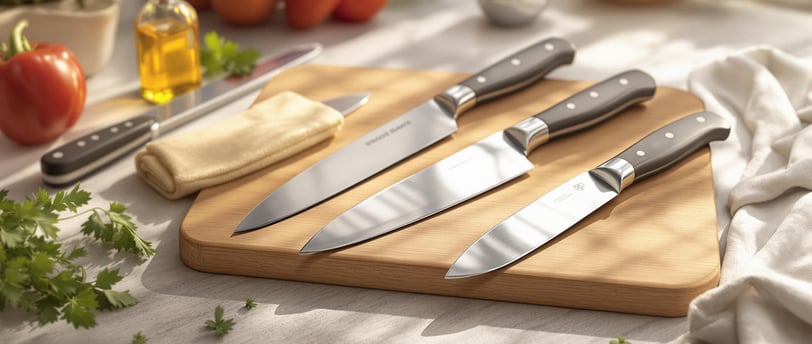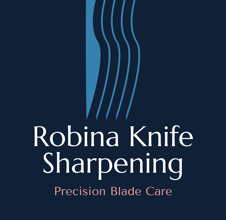Robina Knife Sharpening Book in for same-day service 0466 156 237 4 TIFFANY CLOSE. ROBINA
Knife Care
Learn essential tips for knife care, from cleaning and storing to honing and sharpening, ensuring they remain sharp and safe.
5 min read


How to Care for Your Newly Sharpened Knives: Essential Tips
A sharp knife is safer and lasts longer when cared for properly. Here’s how to keep yours in top condition:
Clean by Hand: Wash with warm water and mild soap, then dry immediately to prevent rust.
Store Safely: Use magnetic holders, knife blocks, or blade protectors to protect edges and avoid accidents.
Use the Right Cutting Boards: Stick to end-grain wood or soft plastic boards - avoid hard surfaces like glass or marble.
Hone Regularly: Use a honing rod weekly (or more often if needed) to keep the blade aligned.
Sharpen When Necessary: Get professional sharpening a few times a year, depending on usage.
How to Take Care of Your Knives
Cleaning Your Knives
Taking care of your knives starts with proper cleaning - it helps maintain their sharp edge and overall condition.
Hand Wash Only
Avoid putting your knives in the dishwasher. The harsh environment can harm the blades.
"A dishwasher can be detrimental to the quality of your knife. They are often too abrasive, and based on the type of detergent used, the process can cause rust or corrosion." – Viola Wüsthof, CEO of knife company Wüsthof [1]
Here’s how to hand wash your knives safely:
Use warm water and mild dish soap.
Hold the knife by the handle, keeping the blade pointed away.
Wipe both sides of the blade gently with a soft cloth.
Rinse thoroughly with clean water.
"I have always hand-washed my knives because the heat, chemicals, and mechanical movement all work together to destroy them [in the dishwasher] in pretty short order." – Shawn Matijevich, Lead Chef of Online Culinary Arts & Food Operations at the Institute of Culinary Education [2]
Dry After Each Use
Robina's humid climate makes drying your knives immediately after washing even more critical. Here's how to do it right:
Use a clean tea towel or microfibre cloth.
Hold the knife by its handle.
Wipe the blade carefully, moving from the spine toward the edge.
Make sure both sides are completely dry.
For knives with wooden handles, ensure they are thoroughly dried to prevent damage. Once dry, store your knives properly to keep them in top shape.
Storing Knives Safely
Here are some practical ways to store your knives securely and efficiently.
Wall-Mounted Magnetic Holders
Magnetic knife strips are a great way to save counter space while keeping your knives within easy reach. To avoid damaging the blade, roll the knife onto the magnet with the spine (not the sharp edge) making contact first. Mount the strip at eye level and ensure the magnet is strong enough to hold your knives securely in place.
Choosing Knife Blocks
Knife blocks offer individual slots for each blade, keeping them organised and protected. When inserting knives, slide them in with the back of the blade first to preserve the cutting edge.
Keep these factors in mind:
Opt for horizontal slots to prevent blade edges from resting on wood.
Make sure the slots are the right size for your knife collection.
Choose blocks made from durable hardwood or food-grade plastic
Using Blade Protectors
If a knife block isn’t practical, blade protectors are a reliable option. These covers are perfect for storing knives in drawers or for safe transport. They come in various sizes to fit different knife styles, whether Asian or European designs, and typically cost between A$6.50 and A$10.50. Select protectors that fit snugly to prevent movement and blade damage.
Safety Tip: No matter which storage method you choose, always handle knives by the handle and keep them out of reach of children.
Best Cutting Surfaces
Choosing the right cutting surface is crucial for maintaining your knife's sharpness. A good cutting surface helps preserve the blade's edge, while the wrong one can dull it quickly. Here's a breakdown of the best options and how to care for them.
Wood and Plastic Boards
Wooden cutting boards, particularly those made from softer hardwoods like Black Walnut or Plantation Teak, are great for keeping your knives sharp. These materials offer a slight flexibility that cushions the blade during cutting.
Important: Avoid glass or marble boards entirely. Their hard surfaces can damage your knife's edge after just a few uses.
For everyday use, Australian hardwoods like Victorian Ash or Tasmanian Oak are strong yet gentle on blades, making them ideal for regular kitchen tasks.
Cutting Board Care
Proper care for your cutting board is just as important as maintaining your knife.
Wooden Boards: Wash with hot, soapy water after each use, dry thoroughly, and occasionally treat with food-grade mineral oil. To remove odours, scrub with coarse salt before rinsing.
Plastic Boards: Replace heavily scored boards since deep grooves can trap bacteria. Sanitise using a solution of 1 tablespoon of liquid chlorine bleach per 3.8 litres of water.
Pro Tip: Use separate boards for raw meat and other foods to avoid cross-contamination. HDPE plastic boards are ideal for raw meat preparation as they can handle stronger sanitising solutions.
When a board develops deep grooves, it's time for maintenance. Wooden boards can often be resurfaced with woodworking tools, while worn-out plastic boards should be replaced to ensure food safety and protect your knives.
Regular Maintenance
Taking care of your knife regularly helps keep its edge sharp and ensures it performs well over time.
Using Honing Rods
A honing rod is a go-to tool for keeping your blade sharp between professional sharpening sessions. It works by realigning the blade's edge without shaving off any material.
Here’s how to hone your knife properly:
Hold the honing rod upright on a stable, non-slip surface. Position the knife's heel at a 15-degree angle against the rod's tip.
Slide the blade down the rod in a smooth motion, pulling it toward you. Use light pressure to realign the edge.
Repeat the process on the opposite side of the blade, alternating sides for a total of 4–5 strokes per side.
"A honing steel will help keep your knives sharp and well aligned in between professional sharpening treatments. Honing doesn't replace professional sharpening – but it will prolong the sharpness of the cutting edge on your knives." – Blade Tech Sharpening Innovations [3
If honing no longer improves your knife's performance, it’s time to consider professional sharpening.
When to Get Professional Sharpening
While honing keeps your knife usable, professional sharpening is necessary to restore its edge fully. Look out for these signs:
Struggling to slice through tomatoes cleanly
Paper tearing during cutting tests
No improvement after honing
Dependant upon knife use we recommend honing your blade frequently to maintain edge alignment and continue enjoying a razor edge in your kitchen, at least once a week for general use."
– Blade Tech Sharpening Innovations [3]
Higher-quality knives tend to stay sharp longer and require less frequent sharpening. When your knife needs professional care, Robina Knife Sharpening offers precise wet stone sharpening starting at A$20 per knife.
Preventing Blade Damage
Correct Uses Only
Always use knives for their specific purpose. For example, a chef's knife is ideal for chopping vegetables, while a bread knife works best for slicing loaves. Misusing a knife can harm its edge. Once you've selected the right knife, handle it carefully to keep the blade in good condition.
Safe Handling
Good handling practices protect both you and your knife. Use a stable, non-slip cutting board on a flat surface. Keep the blade clean while working by wiping it with a damp cloth between tasks.
Once you've mastered proper use and handling, it's time to focus on preventing rust.
Rust Prevention
Moisture is a blade's worst enemy, especially for high-carbon steel knives. After using your knife, wash it with warm, soapy water and dry it completely. For long-term storage, apply a thin layer of mineral oil. For carbon steel blades, a light coat of camellia oil offers extra rust protection.
Conclusion
Taking care of your knives isn't a one-time task - it’s something you need to keep up with regularly. From cleaning and storing to honing, these steps help ensure your knives stay in top condition. By washing them properly, storing them securely, and using the right cutting surfaces, you can keep that sharp edge intact for longer.
Good knife care not only improves safety but also boosts cutting performance and extends the life of your blades. When you clean, store, and maintain your knives correctly, they’ll stay reliable and ready for all your cooking needs.
Consistent upkeep means your knives will stay sharp, making food preparation safer and easier for years to come. By working these habits into your routine, you’ll keep your knives in great shape, ensuring every slice, chop, and dice is smooth and precise.
Contact
© 2025. All rights reserved.
4 Tiffany Close
Robina 4226

